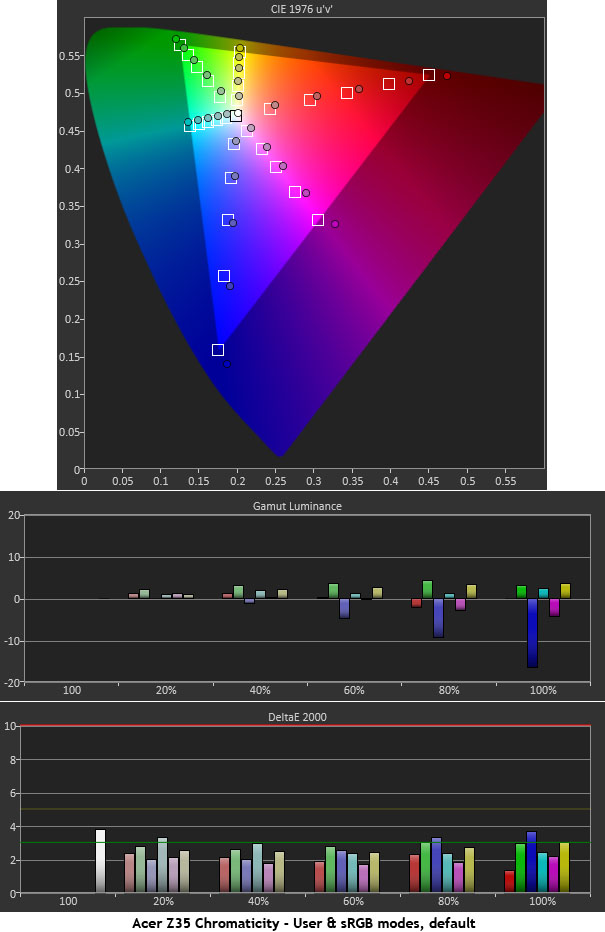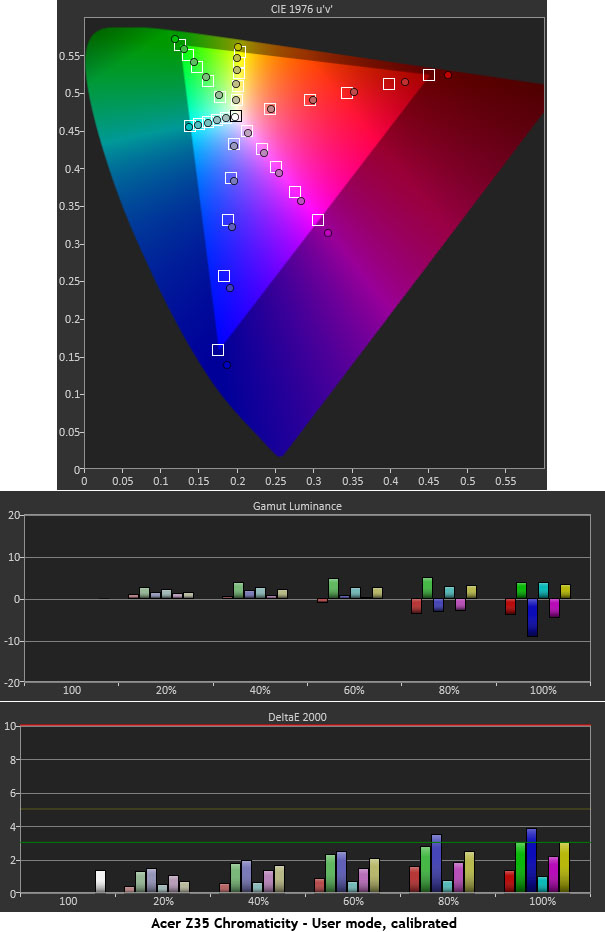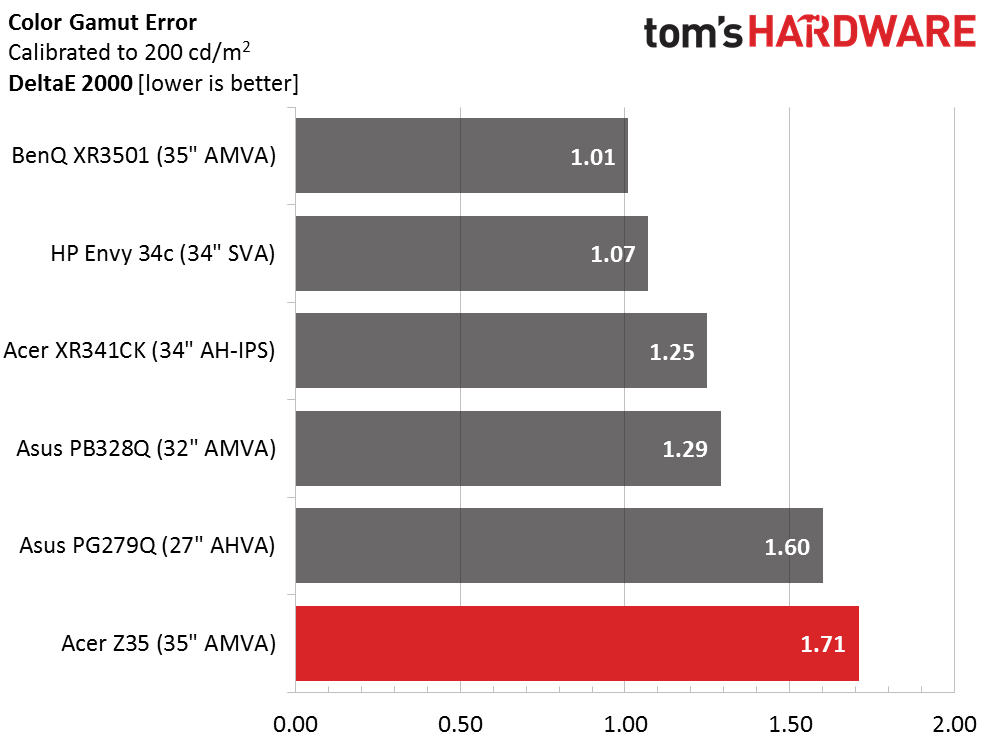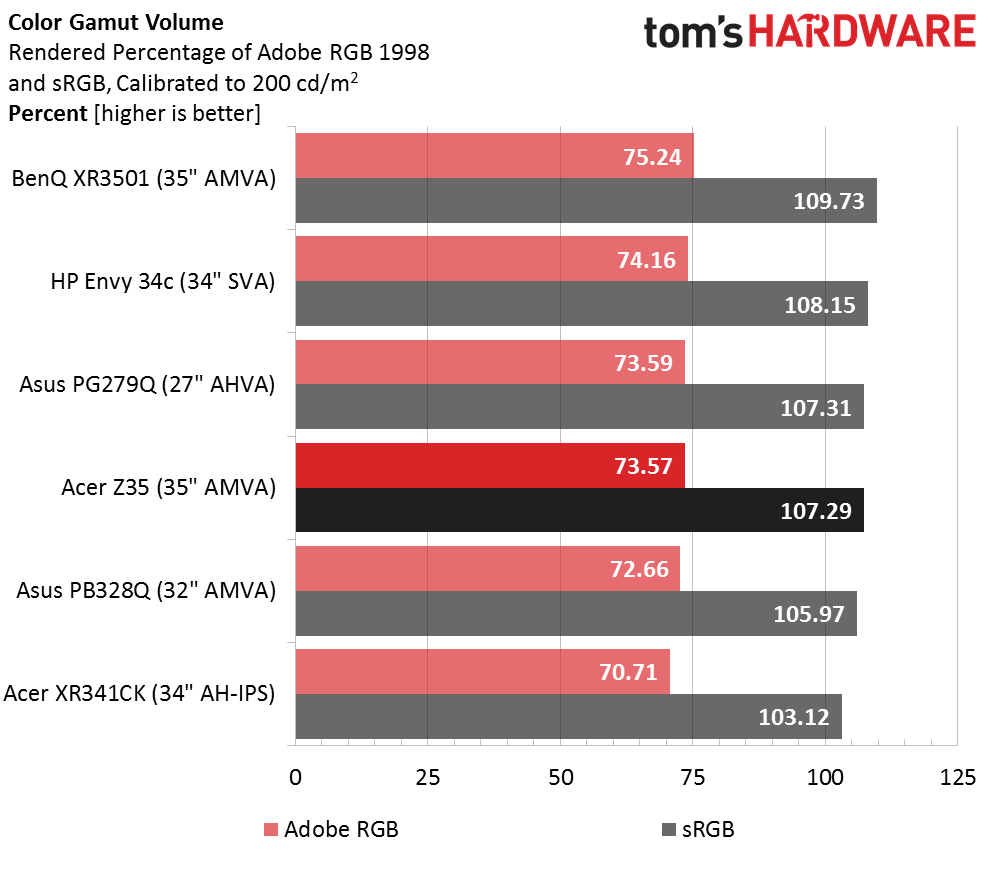Acer Predator Z35 35-inch Curved G-Sync Monitor Review
Why you can trust Tom's Hardware
Color Gamut And Performance
For details on our color gamut testing and volume calculations, please click here.
Even though the Z35 has color saturation adjustments, we prefer to see accurate gamut performance in the monitor's default state. Since it tracks gamma properly and has decent grayscale tracking, there are no real problems in this test. All colors are a bit over-saturated; red, magenta and blue by the greatest amount. In actual content, you'll see just a little more boldness, which will likely please many users. We didn't see any fault when we played games, watched video or tended to workaday tasks. The average error here is a low 2.54dE.
Calibration improves both hue and luminance a little, though the visual difference is small. Red, magenta and blue are still over-saturated and manipulating the 6-axis controls won't help. They only affect luminance, which is already where it should be. It's good that the aforementioned three colors have a slight drop in brightness because that compensates for their saturation error. Overall performance here is excellent.
Now we return to the comparison group.
The fact that the Z35 is in last place doesn't mean it has a deficiency in color accuracy. It's just that the other screens are so good. Plenty of pro-displays can't boast color errors this low so there's no cause for concern with any of these products. It doesn't get much better than this at any price point or in any display category.
Gamut Volume: Adobe RGB 1998 And sRGB
The red/magenta/blue over-saturation means there's a little bonus sRGB gamut volume. Color-critical work will need to be accompanied by a software LUT but since there's extra color to work with, that's a good thing.
Get Tom's Hardware's best news and in-depth reviews, straight to your inbox.
Current page: Color Gamut And Performance
Prev Page Grayscale Tracking And Gamma Response Next Page Viewing Angles, Uniformity, Response, Lag, G-Sync And ULMB
Christian Eberle is a Contributing Editor for Tom's Hardware US. He's a veteran reviewer of A/V equipment, specializing in monitors. Christian began his obsession with tech when he built his first PC in 1991, a 286 running DOS 3.0 at a blazing 12MHz. In 2006, he undertook training from the Imaging Science Foundation in video calibration and testing and thus started a passion for precise imaging that persists to this day. He is also a professional musician with a degree from the New England Conservatory as a classical bassoonist which he used to good effect as a performer with the West Point Army Band from 1987 to 2013. He enjoys watching movies and listening to high-end audio in his custom-built home theater and can be seen riding trails near his home on a race-ready ICE VTX recumbent trike. Christian enjoys the endless summer in Florida where he lives with his wife and Chihuahua and plays with orchestras around the state.
-
Realist9 The only 'gamer' I see buying this monitor is one that wants super mega hecka uber duper high refresh rate for their twitch FPS and doesn't care that the image looks crappy.Reply
Seriously, why not 1440, at least? -
SBMfromLA Reply17582662 said:The only 'gamer' I see buying this monitor is one that wants super mega hecka uber duper high refresh rate for their twitch FPS and doesn't care that the image looks crappy.
Seriously, why not 1440, at least?
Some people feel a need to have the "latest and greatest"... -
turkey3_scratch Reply17582662 said:The only 'gamer' I see buying this monitor is one that wants super mega hecka uber duper high refresh rate for their twitch FPS and doesn't care that the image looks crappy.
Seriously, why not 1440, at least?
It's a simple answer: CSGO. Competitive players want these high refresh rates. -
envy14tpe Reply17582662 said:The only 'gamer' I see buying this monitor is one that wants super mega hecka uber duper high refresh rate for their twitch FPS and doesn't care that the image looks crappy.
Seriously, why not 1440, at least?
It's a simple answer: CSGO. Competitive players want these high refresh rates.
Don't forget us BF4 players. We like the high refresh rates too. But for $300-400 less you could get a 1440p IPS panel like the PG279Q that runs up to 165Hz. That's why this bigger screen seems kinda weird given the price. At that price resolution should matter more. -
Jack_565 "You'll need to use the former for G-Sync and for 200Hz operation, which also requires a GeForce GTX960 BOOST or better"Reply
Could someone clarify what a 960 BOOST is, a OC'd 960? -
ohim The thing with G-Sync is that every gamer in Battlefield 4 forums said that they use their monitors without G-Sync when gaming at 144hz, i asked them why and they all replied that it`s a pointless tech at that fps speed.. so practically you pay for G-sync only on the slower games where you can`t reach to fast fps.Reply -
Max_x2 Did any of you actually read the article? First paragraph under the specs, right on the first page:Reply
"Those who have browsed the specs certainly noticed the 2560x1080 pixel resolution. That's something we weren't thrilled to see in the XR3501 either but after testing and playing games on it for a while, the lower pixel density became a non-issue. We continue to maintain that contrast is the most important factor in image quality, not resolution. And the Z35 is no different."



